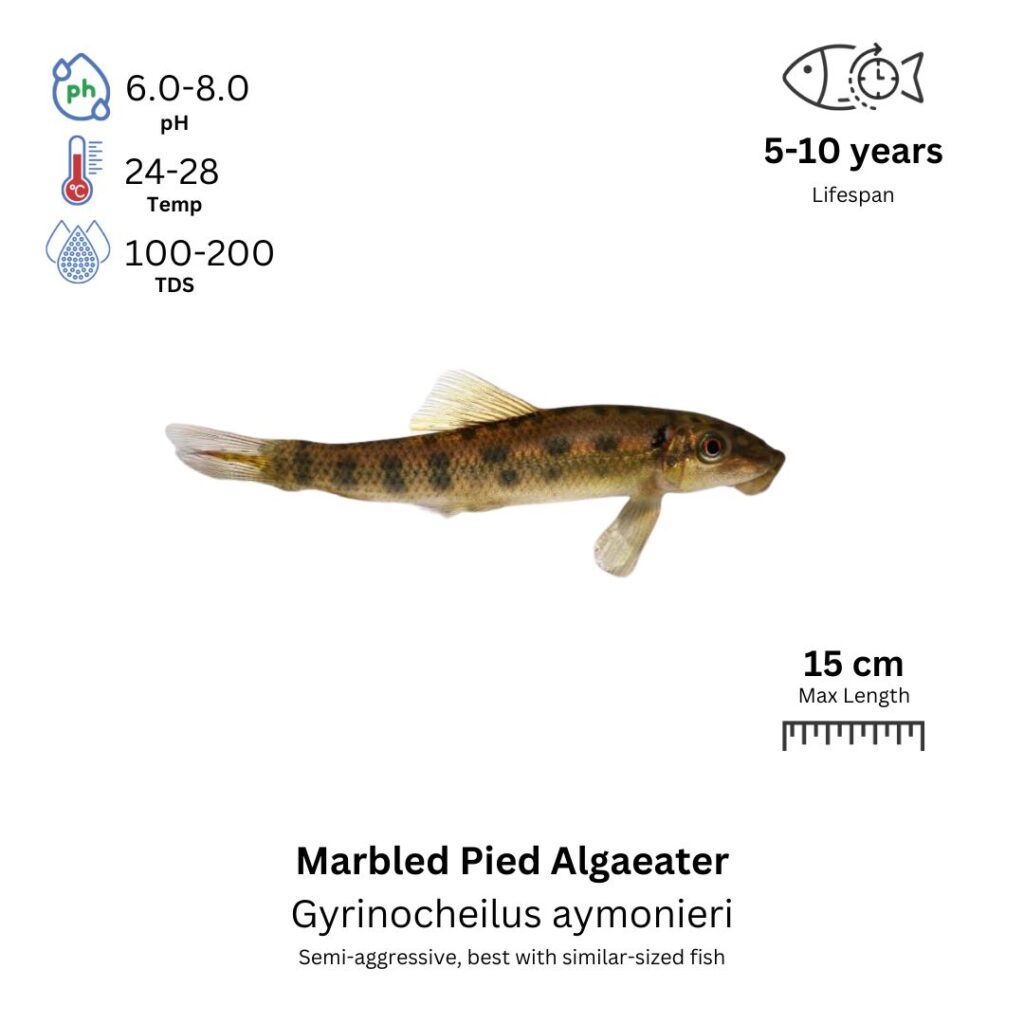Marbled Pied Algaeater
Gyrinocheilus pennocki

Description
The Marbled Pied Algaeater, also known as the Siamese Algae Eater or Chinese Algae Eater, is a distinctive and hardy freshwater fish popular in aquariums for its algae-eating capabilities. It has an elongated, torpedo-shaped body that is typically brown to grayish-green in color, adorned with darker marbled patterns or patches that give it a “pied” appearance. Its color can sometimes range from a dull olive or brown with black markings to a lighter, more translucent body. The fish has a wide, slightly flattened head, large eyes, and a ventral sucker that it uses to cling to surfaces while it feeds.
Habitat Origin
The Marbled Pied Algaeater is native to Southeast Asia, particularly in countries like Thailand, Laos, and Cambodia, where it inhabits slow-moving, murky waters in rivers and streams. These waters tend to be warm, slightly acidic to neutral, with moderate flow and plenty of submerged rocks and plants. In the wild, these fish are commonly found in regions with abundant algae on which they feed.
Aquarium
Ideal Number in Aquarium: Best kept in groups of at least 2-3 individuals, as they are social creatures that do better with company. However, in smaller tanks, a single individual will suffice.
Favorite Food

While the Marbled Pied Algaeater is known for its algae-eating habits, it is an omnivore and will accept a variety of foods. They can be fed high-quality algae wafers, sinking pellets, and vegetable matter such as spirulina, blanched zucchini, and spinach. They will also benefit from occasional live or frozen foods like brine shrimp, bloodworms, and daphnia. It’s essential to supplement their diet with other foods to ensure they maintain good health and vibrancy.
Behavior:
Marbled Pied Algaeaters are generally peaceful fish that enjoy swimming in the middle and lower regions of the tank. They are quite active, especially when foraging for food, and often cling to surfaces such as tank walls, rocks, and plants to feed on algae. They are excellent algae grazers and will help keep your tank clean, but they can be a little territorial when it comes to feeding spots, particularly as they mature. They are not particularly aggressive, but they may compete with other fish for food or space.
Special Care:
While the Marbled Pied Algaeater is a hardy fish, it does require stable water conditions. Regular water changes, good filtration, and a well-maintained tank are necessary to keep the water clean and clear, as these fish are sensitive to poor water quality. They also appreciate having plenty of hiding spots in the form of rocks, plants, or caves. They are not particularly picky about their environment but should not be kept in tanks with delicate or slow-moving fish, as they might compete for food or space.
Compatibility with Other Fish:
Marbled Pied Algaeaters are compatible with a variety of peaceful species. They are commonly housed with other algae-eating species, such as Otocinclus or Amano shrimp, and can live with other non-aggressive fish such as tetras, rasboras, and corydoras. However, they may become territorial with other bottom-dwelling species or during feeding, so it’s important to ensure there is enough space and hiding spots in the tank. Avoid keeping them with slow-moving or very small fish that may be stressed or outcompeted for food.
Breeding Setup
Setting up a separate breeding tank is highly recommended for Marbled Pied Algaeaters, as they can become territorial and stressed in a community setting. A tank of at least 100 liters (25 gallons) provides enough space for spawning behavior and fry development. Maintain water parameters at a pH of 6.5–7.5, temperature of 24–28°C, and hardness around 6–12 dGH. A gentle sponge filter or low-flow internal filter is ideal to keep the water clean without producing strong currents. Use fine gravel or sand substrate, and include flat rocks or tank glass as potential spawning sites. Java moss or Anubias can be added to simulate natural cover. Moderate lighting with a 10–12 hour cycle, combined with shaded zones or floating plants, helps reduce stress and promotes natural behavior.
Conditioning for Breeding
To prepare the breeding pair, feed a high-quality, protein-rich diet including live or frozen foods such as brine shrimp, bloodworms, and daphnia, alongside algae wafers or premium flakes. This encourages egg development in females and enhances courtship displays in males. Perform partial water changes (20–30% weekly) to maintain optimal water quality. A slight increase in temperature to around 28°C (82°F) can help mimic breeding season conditions and trigger spawning responses.
Spawning Process
Spawning usually occurs under stable, well-maintained conditions, often in the early morning or late evening. Males begin by displaying to females, sometimes chasing them as part of their courtship. The female lays 100–300 eggs on flat surfaces such as glass, smooth rocks, or driftwood, and the male fertilizes them externally. In many cases, adults can remain with the eggs, as they are not known for egg predation and may even assist by fanning the eggs for oxygenation. However, some breeders prefer to remove the adults for added safety.
Fry Care
Eggs typically hatch within 2–4 days, depending on temperature. Once free-swimming, fry should be fed with infusoria or liquid fry food. After the first week, transition them to newly hatched brine shrimp, crushed flakes, or microworms to support rapid growth. Maintain clean water with small, frequent water changes (10–15% every 2–3 days) and use a sponge filter to avoid disturbing the fry. Keep temperature stable at 24–28°C, and eliminate strong currents to minimize stress.
Breeding Readiness & Stress Management
Sexual maturity is usually reached between 6–9 months, depending on individual health and size. Males are more vibrant and active, showing stronger coloration, especially during breeding, while females are rounder with a fuller belly when carrying eggs. To minimize stress, avoid overcrowding, maintain stable water conditions, and remove aggressive or incompatible tankmates. Providing a peaceful, stable environment is key to successful spawning and fry survival.
